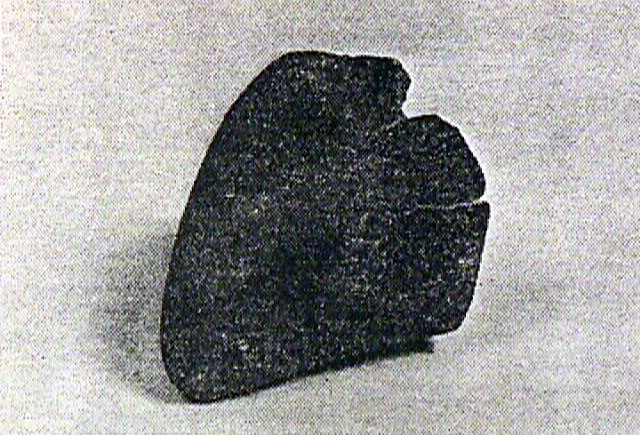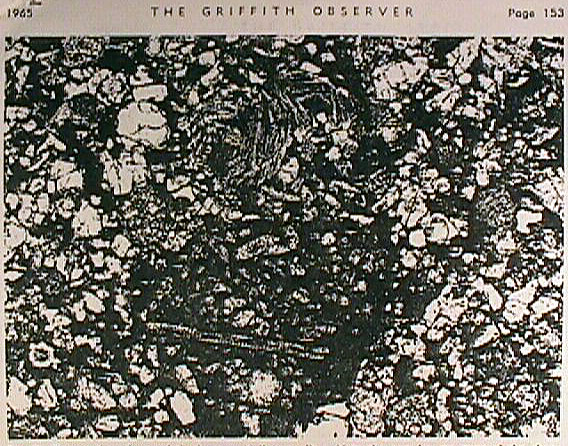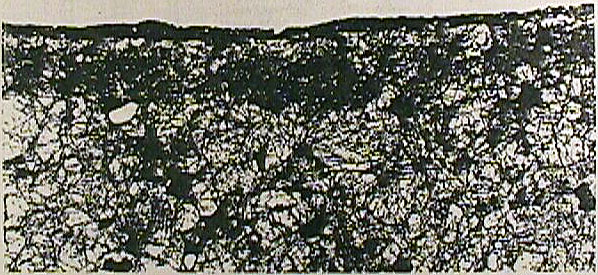
*Fig. 1. Sixteen-gram stony meteorite found on Lucerne Dry Lake by R. N. Hartman. note the contraction cracks in the fusion crust.
(The following article was written by Ron Oriti and is from the November 1965 issue of the "Griffith Observer", reprinted with the authors permission - ed.)
THE LUCERNE VALLEY AEROLITES

*Fig. 1. Sixteen-gram stony meteorite found on Lucerne Dry Lake by R. N. Hartman. note the contraction cracks in the fusion crust.
When a meteorite collector wishes to hunt for meteorites he almost invariably goes to a place where meteorites have already been found. It would be foolish simply to choose any area at random and begin searching, for the chances of finding a meteorite at random are almost nil. The discovery of the Lucerne Valley meteorites, however, appears at first to be an example of a haphazard find. now, though it will not be denied that the element of chance was an important ingredient in the discovery of meteorites in Lucerne Valley, it should be made clear that the Lucerne Valley meteorites were found as a result of a purposeful search of dry lakes in southern California.

*Fig. 2. Thin-section of Lucerne Valley aerolite showing chondrules, rounded grains which often possess intricate structure and are never found in terrestrial rocks. Irregular black patches are flecks of nickel-iron metal. They appear black here because they do not transmit any light, which in this case comes from beneath the section. (Fig. 2, 3, and 5, courtesy of Lowell S. Weymouth, photographer, Geology Department, U.C.L.A.)
The preceding article, "Dry Lakes and Meteorites" gives the reasons why we considered dry lakes to be good hunting grounds for meteorites. The location of such dry lakes with respect to the California meteorite finds was evaluated by my colleague, Ronald N. Hartman, who is a science teacher in the Los Angeles City School system, and a planetarium lecturer here at the Observatory. He decided that Lucerne Dry Lake should be one of the first to be searched, and on July 21, 1963, he began the initial survey. After a long afternoon in the hot sun, he was rewarded by finding the first specimen, one weighing 16 grams. (Fig. 1). It lay on the surface in plain view surrounded by a few other pebbles. It was a typical aerolite (stony meteorite) having a black fusion crust and containing flecks of nickel-iron, and rounded grains called chondrules (Fig. 2 and 3).

*Fig. 3. Thin-section of one of the Lucerne Valley aerolites. Note the complex structure of the chondrules. A plate-like mineral seen edge-on appears as a rod.

*Fig. 4. Five Lucerne Valley aerolites. The relatively good state of preservation of these meteorites indicates that they probably fell within the last 100 years.
During the next few weeks, Hartman was joined by Roderick W. Leonard and me, and six more meteorites were found, the largest of which weighed 37 grams (Fig. 4). Those seven meteorites were all we found; discouraged after many unsuccessful trips, we abandoned the hunt for more than a year.
During that year I have a number of talks on meteorites to residents of the Antelope Valley area, and on a couple of occasions spoke at Antelope Valley High School in Lancaster. I was impressed by the excellent facilities they had for teaching science, and by the enthusiasm of Howard Lieberman and Thomas Nash in the science department. Mr. Lieberman suggested that, perhaps, the science club which he sponsored could join us in one of our meteorite hunts. He said that about a hundred students in the club would be willing to take part. And so it was, that on December 5, 1964 the first large-scale meteorite expedition in the United States took place. More than a hundred students were assembled on Lucerne Dry Lake. (See cover photo). They were equipped with collecting bags and given orders to collect every rock and pebble that they encountered. The students keeping in line swept over large portions of the lake and picked up all visible rocks. It must have seemed very puzzling to those who drove by, to see such a great line of people marching in such a desolate place. A table was set up on the lake, and the students in turn emptied their collecting bags while Leon Hall and Roderick Leonard of the Griffith Observatory and I examined the specimens. The results were disappointing; the largest meteorite, and by coincidence, the two-gram prize was found by Steve Lieberman, son of Howard Lieberman.
Many months later still another small meteorite (three grams) was found by Darryl Futrell after searching a few days. This brought the total number of meteorites found on the lake to nine. Their aggregate weight amounted to a little over 100 grams.
John Buddhue of the Meteoritical Society analyzed one of the specimens and found it to contain about 3.5% nickel-iron. This is a relatively small amount of nickel-iron, but it was enough at least to allow the piece to be pulled by a magnet.

*Fig. 5. Thin-section revealing the three layers in the fusion crust of the first Lucerne Valley aerolite.
A thin-section of the first Lucerne Valley stone clearly revealed the three layers of the fusion crust (Fig. 5). The fusion crust of a meteorite is a thin veneer formed at the time the meteorite stops glowing and its molten surface solidifies. This usually occurs at altitudes above ten miles. Just how the three layers are formed is not completely understood. The three layers, from the outside in, are termed the fusion zone, absorption zone, and impregnation zone, respectively. The fusion zone appears to be composed of a black glass. The following table, according to Buddhue, compares the thicknesses in millimeters of the fusion crust of the first Lucerne Valley aerolite with three other aerolites.
Fusion Absorption Impregnation
Zone Zone Zone Total
Lucerne Valley 0.1 0.1 0.3 0.5
Bjurbole 0.1 0.2 0.3 0.6
Rangala 0.2 0.2 0.6 1.0
Varpaisjarvi 0.05-0.1 0.1-0.2 0.3-0.4 0.3-0.7
As a meteorite plunges through the atmosphere it compresses the air in front of it producing a region of high pressure, while immediately behind the meteorite is a region of low pressure or partial vacuum. As the molten material flows into the low pressure region it rapidly boils away or froths, leaving tiny holes in the crust. These may be seen on the back of one of the Lucerne Valley stones (Fig. 6).

*Fig. 6. Pitting on the back on one of the Lucerne Valley specimens.
The meteorites of Lucerne Dry Lake are of small size, but of great interest. They comprise the nineteenth meteorite find in California. We feel confident that they are just the first meteorites to be recovered by our survey; meteorites from other dry lakes will be forthcoming.
-Ronald A. Oriti